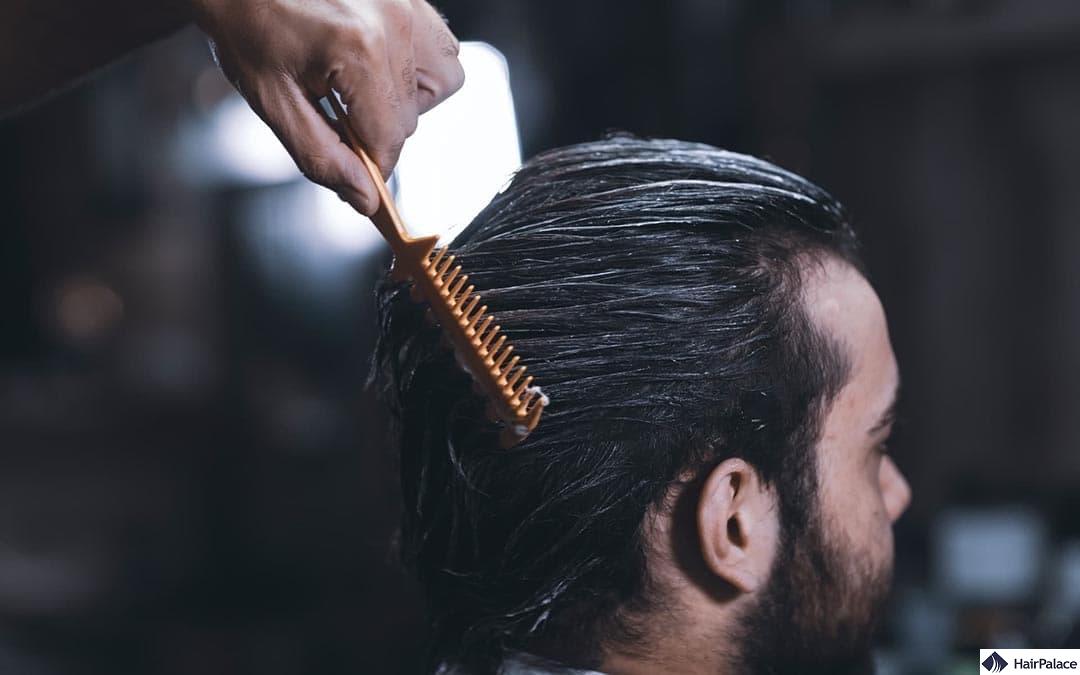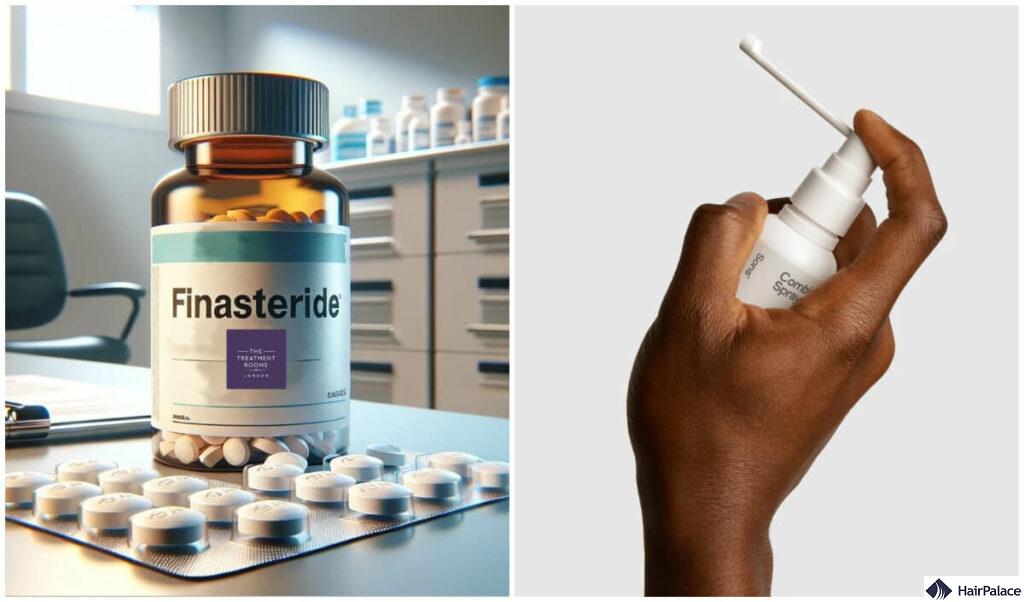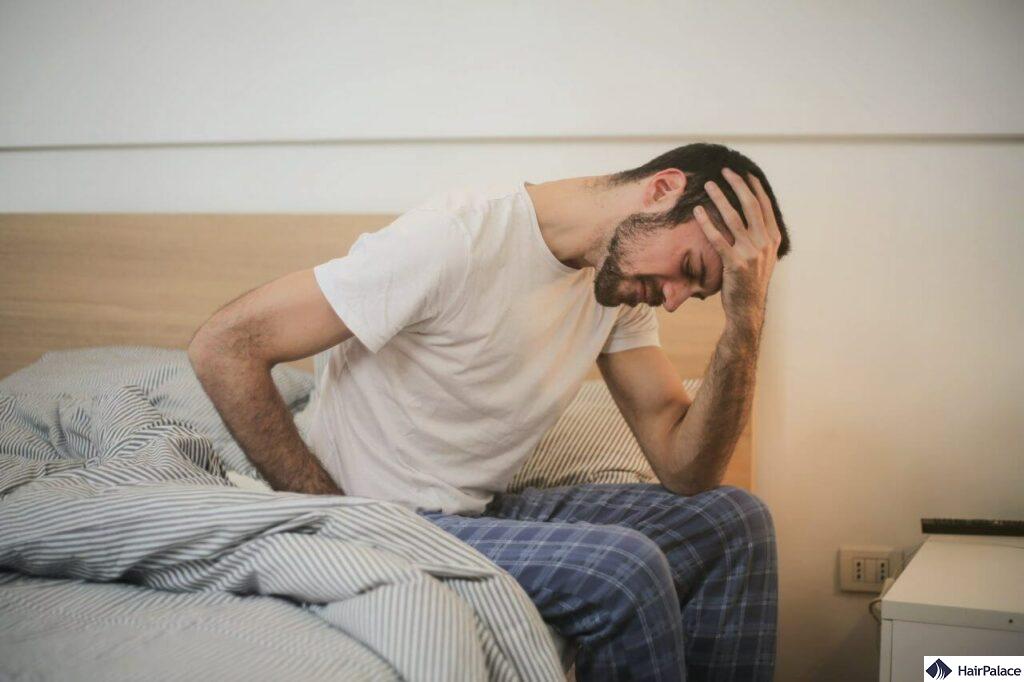Topical Finasteride vs Oral Finasteride: Is There a Difference?

When it comes to treating hair loss, both topical and oral finasteride have gained significant attention and debate among patients and healthcare providers.
This article explores the key differences between these two forms of finasteride, examining their effectiveness, side effects, and suitability for various individuals.
By understanding these distinctions, you can make a more informed decision about which treatment option might be best for you.
- What is finasteride?
- Topical finasteride vs oral
- Side effects
- What works better?
- Results
- Can you use them at the same time?
What is finasteride?
Finasteride is a medication primarily used to treat male pattern hair loss.
It is an oral drug that works by inhibiting the enzyme 5-alpha-reductase.
This enzyme converts testosterone into dihydrotestosterone (DHT), a hormone that plays a key role in developing these conditions.
By reducing the levels of DHT, finasteride can help shrink the prostate and prevent hair loss.
Topical Finasteride vs oral
| Oral | Topical | |
|---|---|---|
| Dose | 1 mg | 0.1% to 0.25% |
| Form | Pill | Solution |
| Cost | £28-£55 | £25 |
| Prescription-only? | Yes | Yes |

Both forms are designed to address similar conditions, but they differ in their method of administration, systemic absorption, and potential side effects.
Oral finasteride tablets
Typically taken as a daily pill, oral finasteride is favoured for its convenience and strong efficacy due to its higher systemic absorption.
The recommended dosage for treating hair loss (androgenetic alopecia) is 1 mg per day, which means one tablet.
Oral finasteride treatment is clinically proven to reduce scalp DHT levels, but it comes with an increased risk of side effects.
Topical finasteride
Topical Finasteride is applied directly to the scalp, targeting the hair follicles while aiming to reduce the risk of systemic side effects.
Similar to oral finasteride, the topical form inhibits the enzyme 5-alpha-reductase, which converts testosterone into dihydrotestosterone (DHT).
By applying it directly to the scalp, topical finasteride treatment focuses on reducing DHT levels in the hair follicles.
This localized application aims to minimize systemic absorption and the associated side effects seen with oral finasteride.
Studies have shown that topical finasteride can effectively promote hair regrowth and prevent further hair loss, similar to oral medication.
Topical finasteride vs oral finasteride side effects

Both topical and oral finasteride are used to treat male pattern baldness, but they have different side effect profiles due to their methods of administration and absorption.
Understanding these differences can help in making an informed decision about which treatment to use.
Oral finasteride side effects
- Decreased libido
- Erectile dysfunction
- Ejaculation disorders
- Depression
- Anxiety
- Breast tenderness or enlargement (gynecomastia)
- Rash
- Testicular pain
- Allergic reactions (e.g., swelling of lips and face, difficulty breathing)
Oral finasteride is absorbed throughout the body, affecting DHT levels systemically, which can lead to the above side effects.
Topical Finasteride Side Effects
- Redness
- Itching
- Irritation at the application site
- Dryness or flaking of the scalp
Topical finasteride is designed to act locally on the scalp, minimizing systemic absorption and thus reducing the risk of systemic side effects.
However, systemic absorption, though limited, can still occur.
What works better oral or topical finasteride?
Oral finasteride is more effective due to higher systemic absorption and widespread DHT reduction but comes with a higher risk of side effects.
It is suitable for those who prefer an easy, once-a-day treatment and can tolerate these potential side effects.
Oral finasteride has been proven to be highly effective in increasing hair growth and improving hair density.
Many clinical trials have shown significant hair regrowth and a reduction in hair loss progression.
Oral administration reduces DHT levels systemically by about 60-70%, lowering DHT levels in the scalp and other tissues.
Preliminary studies and clinical trials indicate that topical finasteride can also effectively promote hair regrowth and prevent further hair loss.
A growing body of research suggests comparable efficacy, but more studies are needed to establish long-term safety and effectiveness.
Topical finasteride vs oral photos
Can you use oral and topical finasteride at the same time?
Oral finasteride users often wonder whether they can further improve their hair density by combining the two treatments. The short answer is yes.
Combining oral and topical finasteride for hair loss might enhance efficacy by reducing dihydrotestosterone levels both locally and systemically.
However, this combined hair loss treatment could increase the risk of side effects, as oral finasteride can cause systemic issues like sexual dysfunction and depression.
Limited research specifically addresses their concurrent use, so it is crucial to consult a healthcare professional for personalized advice.
Close monitoring by a healthcare provider is essential if both forms are used together to manage potential risks and ensure effectiveness.
Can you use minoxidil with topical finasteride?
Minoxidil can be used in conjunction with topical finasteride to treat androgenetic alopecia (pattern hair loss).
Combining these two treatments can be more effective than using either one alone, as they work through different mechanisms to promote hair growth and reduce hair loss.
However, their combined use typically comes with an increased risk of side effects such as redness and irritation.
Last medically reviewed on July 31st, 2024
- Lynn Drake, Maria Hordinsky, Virginia Fiedler, et al. The effects of finasteride on scalp skin and serum androgen levels in men with androgenetic alopeciahttps://www.jaad.org/article/S0190-9622(99)80051-6/
- Kaufman KD Clinical studies on effects of oral finasteride, a type 2 5α-reductase inhibitor, on scalp hair in men with male pattern baldnesshttp://scholar.google.com/scholar?hl=en&q=Kaufman+KD+Clinical+studies+on+effects+of+oral+finasteride%2C+a+type+2+5%CE%B1-reductase+inhibitor%2C+on+scalp+hair+in+men+with+male+pattern+baldness.in%3A+Van+Neste+D+Randall+VA+Hair+research+for+the+next+millennium.+Proceedings+of+the+First+Tricontinental+Meeting+of+Hair+Research+Societies%2C+Oct+8%E2%80%9310%2C+1995%2C+Brussels%2C+Belgium+Elsevier+Science+BV%2C%0A+Amsterdam+%28Netherlands%291996%3A+363-365
- Diani AR, Mulholland MJ, Shull KL, Kubicek MF, Johnson GA, Schostarez HJ et al. Hair growth effects of oral administration of finasteride, a steroid 5α-reductase inhibitor, alone and in combination with topical minoxidil in the balding stumptail macaquehttps://www.jaad.org/servlet/linkout?suffix=e_1_3_1_2_15_2&dbid=8&doi=10.1016/S0190-9622(99)80051-6&key=1309834&cf=
- Kaufman KD, Olsen EA, Whiting D, Savin R, DeVillez R, Bergfeld W, Price VH, Van Neste D, Roberts JL, Hordinsky M, Shapiro J, Binkowitz B, Gormley GJ. Finasteride in the treatment of men with androgenetic alopecia. Finasteride Male Pattern Hair Loss Study Group. J Am Acad Dermatol. 1998 Oct;39(4 Pt 1):578-89. doi: 10.1016/s0190-9622(98)70007-6. PMID: 9777765.https://pubmed.ncbi.nlm.nih.gov/9777765/
- Rossi A, Caro G. Efficacy of the association of topical minoxidil and topical finasteride compared to their use in monotherapy in men with androgenetic alopecia: A prospective, randomized, controlled, assessor blinded, 3-arm, pilot trial. J Cosmet Dermatol. 2024 Feb;23(2):502-509. doi: 10.1111/jocd.15953. Epub 2023 Oct 5. PMID: 37798906.https://pubmed.ncbi.nlm.nih.gov/37798906/
- Piraccini BM, Blume-Peytavi U, Scarci F, Jansat JM, Falqués M, Otero R, Tamarit ML, Galván J, Tebbs V, Massana E; Topical Finasteride Study Group. Efficacy and safety of topical finasteride spray solution for male androgenetic alopecia: a phase III, randomized, controlled clinical trial. J Eur Acad Dermatol Venereol. 2022 Feb;36(2):286-294. doi: 10.1111/jdv.17738. Epub 2021 Oct 25. Erratum in: J Eur Acad Dermatol Venereol. 2023 Feb;37(2):452. doi: 10.1111/jdv.18750. PMID: 34634163; PMCID: PMC9297965.https://pubmed.ncbi.nlm.nih.gov/34634163/





